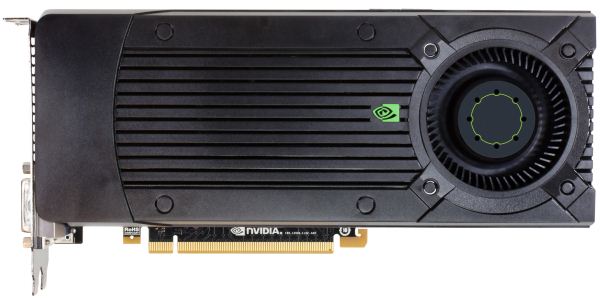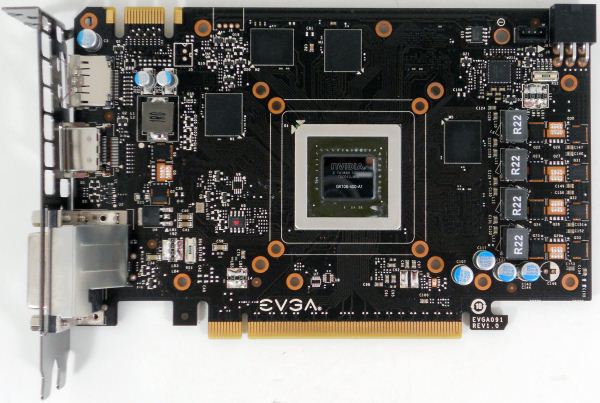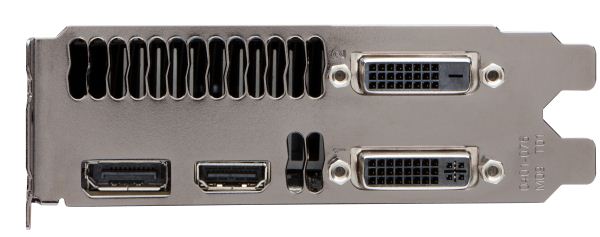The NVIDIA GeForce GTX 660 Review: GK106 Fills Out The Kepler Family
by Ryan Smith on September 13, 2012 9:00 AM ESTMeet The GeForce GTX 660
For virtual launches it’s often difficult for us to acquire reference clocked cards since NVIDIA doesn’t directly sample the press with reference cards, and today’s launch of the GeForce GTX 660 launch is one of those times. The problem stems from the fact that NVIDIA’s partners are hesitant to offer reference clocked cards to the press since they don’t want to lose to factory overclocked cards in benchmarks, which is an odd (but reasonable) concern.
For today’s launch we were able to get a reference clocked card, but in order to do so we had to agree not to show the card or name the partner who supplied the card. As it turns out this isn’t a big deal since the card we received is for all practical purposes identical to NVIDIA’s reference GTX 660, which NVIDIA has supplied pictures of. So let’s take a look at the “reference” GTX 660.
The reference GTX 660 is in many ways identical to the GTX 670, which comes as no great surprise given the similar size of their PCBs, which in turn allows NVIDIA to reuse the same cooler with little modification. Like the GTX 670, the reference GTX 660 is 9.5” long, with the PCB itself composing just 6.75” of that length while the blower and its housing composes the rest. The size of retail cards will vary between these two lengths as partners like EVGA will be implementing their own blowers similar to NVIDIA’s, while other partners like Zotac will be using open air coolers not much larger than the reference PCB itself.
Breaking open one of our factory overclocked GTX 660 (specifically, our EVGA 660 SC using the NV reference PCB), we can see that while the GTX 670 and GTX 660 are superficially similar on the outside, the PCB itself is quite different. The biggest change here is that while the 670 PCB made the unusual move of putting the VRM circuitry towards the front of the card, the GTX 660 PCB once more puts it on the far side. With the GTX 670 this was a design choice to get the GTX 670 PCB down to 6.75”, whereas with the GTX 660 it requires so little VRM circuitry in the first place that it’s no longer necessary to put that circuitry at the front of the card to find the necessary space.
Looking at the GK106 GPU itself, we can see that not only is the GPU smaller than GK104, but the entire GPU package itself has been reduced in size. Meanwhile, not that it has any functional difference, but GK106 is a bit more rectangular than GK104.
Moving on to the GTX 660’s RAM, we find something quite interesting. Up until now NVIDIA and their partners have regularly used Hynix 6GHz GDDR5 memory modules, with that specific RAM showing up on every GTX 680, GTX 670, and GTX 660 Ti we’ve tested. The GTX 660 meanwhile is the very first card we’ve seen that’s equipped with Samsung’s 6GHz GDDR5 memory modules, marking the first time we’ve seen non-Hynix memory on a GeForce GTX 600 card. Truth be told, though it has no technical implications we’ve seen so many Hynix equipped cards from both AMD and NVIDIA that it’s refreshing to see that there is in fact more than one GDDR5 supplier in the marketplace.
For the 2GB GTX 660, NVIDIA has outfit the card with 8 2Gb memory modules, 4 on the front and 4 on the rear. Oddly enough there aren’t any vacant RAM pads on the 2GB reference PCB, so it’s not entirely clear what partners are doing for their 3GB cards; presumably there’s a second reference PCB specifically built to house the 12 memory modules needed for 3GB cards.
Elsewhere we can find the GTX 660’s sole PCIe power socket on the rear of the card, responsible for supplying the other 75W the card needs. As for the front of the card, here we can find the card’s one SLI connector, which like previous generation mainstream video cards supports up to 2-way SLI.
Finally, looking at display connectivity we once more see the return of NVIDIA’s standard GTX 600 series display configuration. The reference GTX 660 is equipped with 1 DL-DVI-D port, 1 DL-DVI-I port, 1 full size HDMI 1.4 port, and 1 full size DisplayPort 1.2. Like GK104 and GK107, GK106 can drive up to 4 displays, meaning all 4 ports can be put into use simultaneously.














147 Comments
View All Comments
Zds - Saturday, September 15, 2012 - link
"Reference clock" is very different from "reference PCB". The operative words are "clock" and "PCB", not "reference".Redshift_91 - Wednesday, September 19, 2012 - link
a superclocked card is not reference clocked, thus the keyword is "reference". Unless you're going to argue that a superclocked card is reference clocked and thus the very idea of overclocking is thrown out the window.guidryp - Thursday, September 13, 2012 - link
"NVIDIA has spent a lot of time in the past couple of years worrying about the 8800GT/9800GT in particular"I am still using a 8800GT without much need to upgrade. I don't play any new games so I really can't justify an upgrade. Though of course you get that upgrade itch. So the first thing I wondered was, how much power/noise compared to my 8800GT (I have giant slow fan on mine).
Anonymous Blowhard - Thursday, September 13, 2012 - link
Now that the 600-series has gotten a firm foothold, older cards like the GTX460 have been available for around $100 if you're patient enough to wait for sales and rebates.Pick one based on the NV reference design if you're concerned about noise; I've had models from MSI and EVGA that both performed admirably in terms of noise and temperature. Blower-style fans can be extremely loud if you buy the wrong model (ZOTAC) so do your homework.
I came from an 8800GT myself and didn't feel the need to upgrade, but there's a definite benefit even in "low end" games based on Source/UE3. The ability to crank up the details/AA and still hold a solid 60fps is wonderful. Well worth the money.
DanNeely - Thursday, September 13, 2012 - link
buying a 2+ generation old high end card is almost never a good idea. What you save upfront over an equivalent lower mid range card is quickly lost due to the significantly higher power draw.rarson - Friday, September 14, 2012 - link
Huh? How expensive is electricity where you live? I can't imagine the power difference making up the cost difference in less than 2 years of constant use.I replaced my 3870 with a 6850 a few months ago, and it actually uses a bit less power at idle, which is where my GPU spends the bulk of its time, so I'm actually saving a tiny bit. Sure, the 460 uses more power under load, but the 880GT uses significantly more power than the 460 during idle (about 20W!).
CeriseCogburn - Thursday, November 29, 2012 - link
If you're worried about 20 watts at idle, you're definitely an amd fanboy.Probably something else too I won't mention since humiliating yourself is already a public past time.
gamara - Thursday, June 6, 2013 - link
20W x 2 days is 1 KW hr. 15 KW hr a month, 180 KW hrs a year. At $.10 a KW hr, that's $18. In California, some places it runs almost triple that, so if you use So Cal Ed, and are in Tier 3 or 4, you pay almost $50 a year extra for those 20 watts.guidryp - Friday, September 14, 2012 - link
I am patient enough to wait for the gtx 660 to get down to $150.If I do upgrade, one thing that is a must, is getting 3+ monitor capability.
I currently drive my TV and desktop monitor, and would like a second desktop monitor.
Here the power usage looks line line with the 8800GT and NVidia finally allows 3+ monitors.
raghu78 - Thursday, September 13, 2012 - link
GTX 660 is actually weak competition. Nvidia's pricing sucks . USD 200 would have really made it an amazing card. Performance wise its stuck between the HD 7850 and HD 7870 but pricing wise its nearer to HD 7870. the GTX 660 is up against a faster chip in the HD 7870. and needs a price correction . GTX 660 OC matches a HD 7870http://www.techpowerup.com/reviews/ASUS/GeForce_GT...
Also anandtech's gaming suite is quite out of date. They are testing Portal 2 which is useless and don't have a single game released in 2012 like Alan Wake, Max Payne 3, Dirt Showdown, Sniper Elite V2, Diablo III, Sleeping Dogs. most sites have started including newer games . hardocp has included sleeping dogs. techpowerup has included alan wake, sniper elite v2, max payne 3, diablo III. techreport has max payne 3 and dirt showdown. And to state that GTX 660 is faster than HD 7870 or the better card with such an obsolete suite is ridiculous